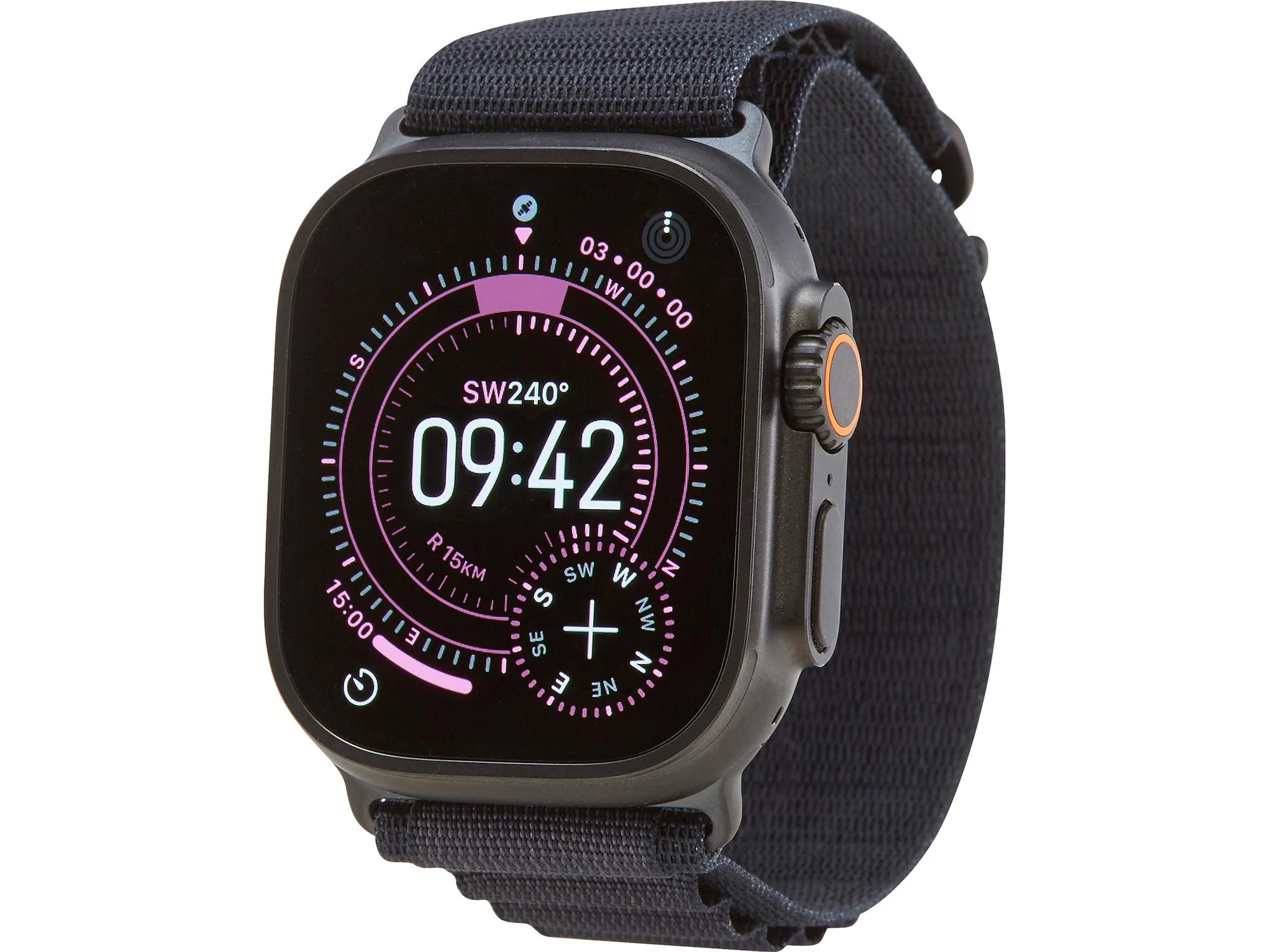By clicking a retailer link you consent to third-party cookies that track your onward journey. This enables W? to receive an affiliate commission if you make a purchase, which supports our mission to be the UK's consumer champion.
Best Apple Watch to buy

Apple is arguably the biggest name in the smartwatches market. An Apple Watch puts your phone’s screen on your wrist, giving you notifications and apps without you needing to get your phone out, plus fitness features and cutting-edge health features.
All the watches share the same design, but they aren't made equal. Processor, price and accuracy are just some of the differences, and features like LTE mean you can leave your iPhone at home if needed and still stay connected. We take a look at the ranges on offer, including the newest Series 11, the Apple Watch Ultra 3, and SE 3.
You can also see how Apple Watches compare with other brands by heading to our list of the best smartwatches.
Logged-in Which? members can view the full Apple Watch results in the table below. If you’re not yet a member, join Which? to get instant access
The best Apple Watch overall
The best budget Apple Watch
The best Apple Watch for adventurers
Not found the product for you? Browse all of our Apple Watch reviews or smartwatch reviews.
Is it worth buying an Apple Watch?
Adam Speight, Which? smartwatches expert, says:

Apple watches have a generous amount of high-end features beyond heart-rate monitoring and step tracking. The latest models can record your ECG to detect irregular heart rhythms, help detect sleep apnoea, and deliver comprehensive smart features you'd find on a smartphone. So, only consider buying one if you're going to make use of a lot of the features.
Also, make sure you have an Apple iPhone before buying one, since Apple watches are only compatible with iPhones. This means they won't work with Android phones at all. See our Android-compatible smartwatch reviews if you have an Android smartphone for alternatives.
How much will an Apple Watch cost?
Whichever watch you go for, you'll have a number of customisation options. So the price you pay will depend on factors like size of the screen, the material of the band and casing, whether you go for a designer version and whether you want LTE (also known as cellular connectivity).
The current range includes the third-generation Apple Watch SE, Series 11, and the Apple Watch Ultra 3. The 2024 series is still on sale, too, featuring the Series 10 and Apple Watch Ultra 2.
The latest Apple Watch Series 11 starts at £399. The SE (pitched as a more affordable Apple Watch – and much cheaper than the others – but clearly still not exactly cheap) starts at around £249. The Apple Watch Ultra 3, built to survive more extreme sports, starts at a frightening £749.
Earlier Apple Watches are no longer available to buy directly from Apple, but some retailers are still selling them while stocks last, and you can pick up second-hand versions from Apple's Refurbished store.
Do Apple watches only work with iPhones?
Yes, you will only be able to use an Apple Watch if you have an iPhone to connect it to. Android phones are not compatible.
Is the Apple Watch waterproof?
The now-discontinued Series 2 was the first range of smartwatches from Apple to be made water-resistant, with a rating of 5ATM (so water resistant to up to 50 metres in depth for 10 minutes). Most recent Apple watches have followed suit. Apple says that the Series 9, 10 and 11 are fine to wear whilst shallow swimming, but they won't be suitable for watersports or diving. However, this comes with the caveat that water-resistance levels can decrease over time. Check your strap is swimproof if you plan to take yours swimming, though.
It’s currently impossible to seal a speaker, because it needs air to produce sound, but Apple has got round this by creating a speaker that lets water in and then uses sound vibrations to eject it back out.

If you want a device that has a higher level of water resistance, consider a watch in the Apple Watch Ultra range (pictured above). It is designed for extreme sports, including water sports. It's able to track scuba dives, for example, and will show you time spent underwater, current depth, water temperature and maximum depth reached.
How long does an Apple Watch battery last?
Battery life – previously an Achilles heel for Apple Watch models – is now much improved. It's still not the longest, and each device can vary, but you won't be tied into daily charging anymore unless you keep the GPS on consistently, which is known to drain smartwatch batteries.
Our battery testing is based on 'typical use' and aims to replicate how long the smartwatch should last you based on how you use it each day. Of the Apple watches currently on the market, the worst battery life we tested lasted just over two days, and the best lasted more than four.
To find out more about how each watch varies, read our Apple smartwatch reviews.
How to choose the best Apple Watch

Find out more about the different features they offer and how they fared in our tests.
- Apple Watch Series 11 review
- Apple Watch Series 10 review
- Apple Watch SE 3 review
- Apple Watch Ultra 3 review
- Apple Watch Ultra 2 review
Exciting features that you'll find on the Series 9 and higher Apple smartwatches include specialised heart monitoring. These watches can:
- Notify you if your heart rate is too high or low
- Detect atrial fibrillation – irregular heart rhythms. Apple is being careful not to say that it definitely will detect this, but it could do
- Take ECG (electrocardiogram) readings, which you can share with your doctor.
They can also detect if you've fallen over and call 999 on your behalf if you've been immobile for a minute. The cellular versions will do this even if you're not near your phone.
The Apple Watch Series 9, 10, 11, Ultra, Ultra 2, and Ultra 3 have a blood-oxygen app, which the SE doesn't. The SE (pictured below) doesn't have the ability to take ECGs, either.

WatchOS
At the heart of every Apple Watch is watchOS, the operating system that makes it all tick. It's designed to work seamlessly and exclusively with Apple's iPhones, so if you're an Android user, this isn't the smartwatch for you.
The interface is built for touch, giving you a huge range of smart features. All the essentials are covered—you can read and reply to messages, take calls from your wrist, and manage notifications. You can also make contactless payments with Apple Pay, use Siri for voice commands, and even unlock your Mac automatically. It's a powerful system that also lets you get competitive with friends by sharing your activity rings and cheering each other on.
Released in September 2025, watchOS 26 is a major update that brings both a visual refresh and some genuinely smart new abilities. The first thing you'll notice is the new "Liquid Glass" design, which gives everything from watch faces to the Control Center a more vibrant and fluid feel. But the real magic lies in the new AI-powered features, which require the processing power of a paired iPhone 15 Pro or newer. These include Workout Buddy, which acts like an AI personal trainer offering real-time encouragement, and Live Translation in the Messages app to break down language barriers. The update also adds a convenient "wrist flick" gesture to dismiss notifications and gives the Phone app a boost with tools like Hold Assist and Call Screening.
This is the important part: The latest watchOS 26 comes pre-installed on the newest Apple Watch models and is available as a free update for the Series 6 and newer. To run it, your watch must be paired with an iPhone 11 or a later model running iOS 26. With this release, Apple has ended software support for the Apple Watch Series 4, Series 5, and the original SE, which cannot be updated beyond watchOS 10. The Apple Watch Series 3 remains stuck on an even earlier version, watchOS 8.
Design
All Apple Watches look similar, with a round-cornered rectangular face, touchscreen display and circular button on the side for scrolling through menus and notifications. As of the Series 4, the digital crown gives haptic feedback (small vibrations) for what Apple calls a more 'precise, mechanical feel'.
Apple has come a long way from the Series 1, which could only be bought with a rubber strap. For the Series 11, available straps include silicone, leather and designer versions. If you already own a band from a previous Apple Watch, you'll be able to use it for the Series 11.
The Apple Watch Ultra 3 and Series 11 have the biggest and brightest Apple Watch screens yet. The SE is slightly smaller.
Processor
For the first time, Apple is using the same processor across its entire new smartwatch lineup. Whether you opt for the high-end Apple Watch Series 11, the rugged Ultra 3, or the affordable SE 3, you're getting the same powerful S10 chip inside.
So, what does that mean for you? The S10 is a 64-bit dual-core processor with a four-core Neural Engine, but this year isn't about a massive leap in speed over the previous generation. Instead, Apple's engineers focused on making the chip smaller, a key change that allowed them to create the new, slimmer design of the Series 11.
While the S10 is more than capable of handling on-device Siri requests and everyday tasks, many of the headline "Apple Intelligence" features in watchOS 26 actually lean on the processing power of a paired iPhone 15 Pro or newer. By putting the same chip in every model, Apple has given the entry-level SE 3 a serious performance boost, ensuring that no matter which watch you choose, you'll get a consistently smooth and fast experience.
Built-in GPS
Built-in GPS lets you track your routes without relying on your smartphone, so you can leave your mobile at home when heading out for a run, for instance. It’s available on models from the Series 3 onwards.
Or, for a much cheaper alternative, head to our guide to buying one of the best cheap smartwatches.
